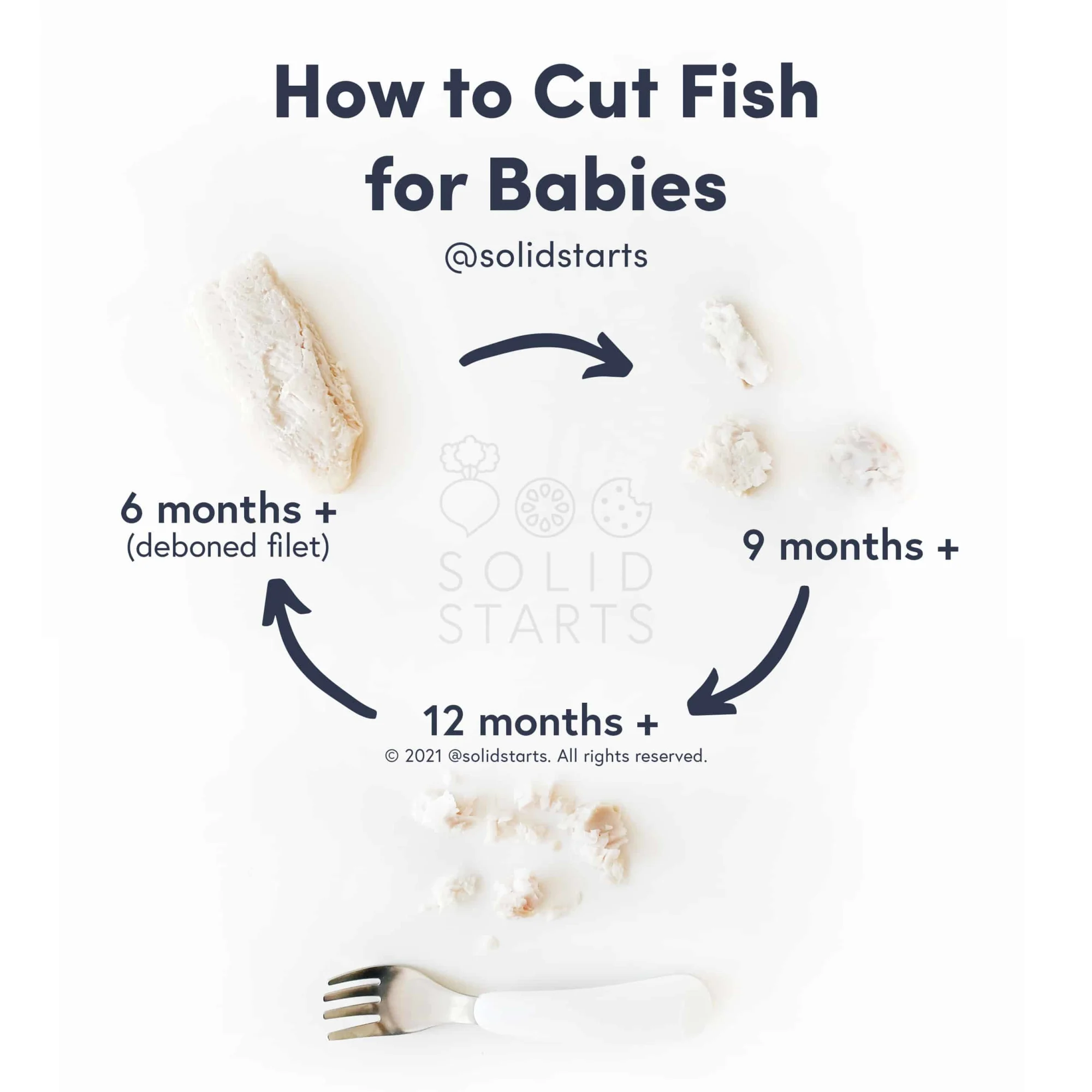Access our First Foods® Database in the Solid Starts App.
Learn moreCod
Fish (Finned)
Age Suggestion
6 months
Iron-Rich
No
Common Allergen
Yes

When can babies have cod?
Cod may be introduced as soon as baby is ready to start solids, which is generally around 6 months old. Compared with other fish, cod tends to have low to moderate levels of mercury.
Cod is one of the most widely eaten fish worldwide, and has been a popular food source for hundreds of years in parts of the world from New England to Norway to Portugal to the UK and beyond. Cod is a mild tasting fish with flaky flesh, and its versatility has led to its wide use in dishes like fish and chips or fish cakes. It has also long been dried and salted to extend its shelflife, then known as bacalao, klippfisk, and saltfish, among other names.
How do you serve cod to babies?
Every baby develops on their own timeline, and the suggestions on how to cut or prepare particular foods are generalizations for a broad audience.
6 months old +:
Offer strips of freshly cooked cod (all bones and skin removed) about the size of two adult fingers pressed together, or flake the fish and mix into other soft, scoopable foods. At this age, you can also offer fish cakes made from cod, as long as they are soft and larger than baby’s mouth.
9 months old +:
Offer bite-sized pieces of freshly cooked cod (all bones and skin removed) for baby to practice picking up with their developing pincer grasp. You can also continue to serve longer strips of cooked cod (all bones and skin removed) or large fish cakes or patties for biting and tearing practice.
12 months old +:
Serve cooked, deboned cod in longer strips, bite-sized pieces, cakes and patties, or flakes on their own or mixed into other foods. This is also a great age to work on utensil practice with foods like cod.
Videos
Is cod a choking hazard for babies?
No. Cooked cod, with bones and skin removed, presents a low risk when safely prepared for a child’s age and developmental ability, though, in theory, an individual could choke on any food. Note that fish bones do pose a risk of getting stuck in the mouth, throat, or esophagus. To reduce this risk, take care to remove the bones from cooked fish, and prepare and serve cod in an age-appropriate way as described in the How to Serve section. As always, create a safe eating environment and stay within reach of baby during meals.
Learn the signs of choking and more about choking first aid in our free guides, Infant Rescue and Toddler Rescue.
Is cod a common allergen?
Yes. Finned fish are classified as a common allergen, and cod is among the most common finned fish allergies, along with halibut, salmon, and tuna. It’s estimated that only 0.2% of people are allergic to finned fish worldwide, and the prevalence of fish allergies in children, while variable, is even less than in adults. About 40% of people with finned fish allergies don’t experience their first allergic reaction until adulthood. Unfortunately, most individuals who are allergic to finned fish do not outgrow the allergy.
Some individuals with finned fish allergy may react from inhaling proteins that become airborne when cooking fish. If this is the case for your baby, you may wish to avoid cooking fish in the household when baby is present.
Around 50% of individuals with one finned fish allergy will react to another fish as well. This is because the major allergen in finned fish, beta-parvalbumin, is present in most fish, regardless of species. Due to the risks of cross-contamination or mislabeling of fish, allergists often recommend that those allergic to one species of finned fish avoid all finned fish until meeting with an allergist to determine which fish might be safely introduced into the diet. This is an individualized recommendation, so be sure to confirm with your allergist before offering other finned fish if baby is allergic to cod.
Finned fish are a known trigger of food protein-induced enterocolitis syndrome, also known as FPIES. FPIES is a delayed allergy to food protein which causes the sudden onset of repetitive vomiting and diarrhea to begin a few hours after ingestion. Left untreated, the reaction can result in significant dehydration. Unlike other food allergens, FPIES to finned fish may not present until later in life, and tends to be life-long.
Lastly, a note on scombroid poisoning, which is sometimes mistaken for a fish allergy. Scombroid poisoning is a type of food poisoning that occurs when someone eats fish that has been improperly refrigerated. This allows a large amount of histamine to build up in the fish. When consumed, this large load of histamine can cause symptoms that mimic those of an allergic reaction, causing some people to believe that they have developed a finned fish allergy, even if they are not allergic. Ensuring that fish has been stored at adequately cool temperatures can minimize the risk of such a reaction.
If you suspect baby may be allergic to fish, consult an allergist before introducing cod. As with all common allergens, introduce cod in small amounts and watch closely as baby eats to see if any adverse reaction occurs. If all goes well, gradually increase the serving size over time. Once common food allergens are successfully introduced, it is recommended to keep them in the diet regularly (twice weekly, if possible). However, this doesn’t mean that each different fish species must be offered multiple times a week. Finned fish share the same major proteins, so it is perfectly acceptable to rotate finned fish varieties according to availability and preference.
Is cod healthy for babies?
Yes. Cod is generally low in mercury and rich in protein, omega 3 fatty acids, choline, magnesium, potassium, selenium, and vitamins B6 and B12. Together, these nutrients support baby’s growth, brain development, vision, heart health, electrolyte balance, hormonal function, metabolic processes, and more.
Our Team
Written by
Expert Tips Delivered to Your Inbox
Sign up for weekly tips, recipes and more!






